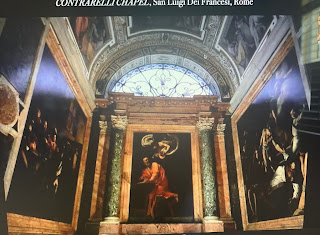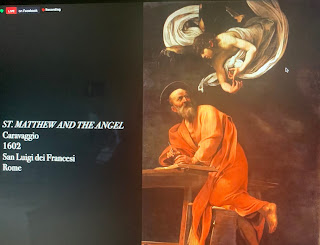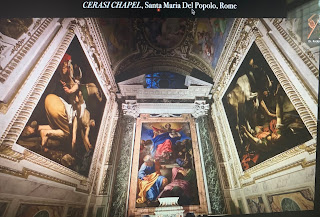Michelangelo Marisi da Caravaggio (1571 - 1610) was (The National Gallery):
... arrogant, rebellious, and a murderer ... short and tempestuous life matched the drama of his works. Characterized by their dramatic, almost theatrical lighting, Caravaggio's paintings were controversial, popular, and hugely influential on succeeding generations of painters all over Europe.
It was this Caravaggio that Dr Rocky Ruggiero sought to portray in a California and Northwest Patron of the Arts lecture titled Caravaggio: "The Cursed Painter." And it is that lecture that I will draw upon to serve as the foundation for the link between the Utrecht Carravagistes and the works of Johannes Vermeer. But more about that later. For the time being, lets explore Carravaggio.
The material in this post draws heavily on the Rocky Ruggiero lecture but is supplemented by additional author research. Many of the Caravaggio paintings used herein are screenshots taken during the course of the Ruggiero lecture.
Caravaggio was born in Milan but his family moved to Caravaggio, a little town in the north of Italy, to escape the plague. At this time, the commune of Caravaggio was considered Venetian territory.
 |
Town of Caravaggio is one of the
northernmost in the above map. |
Caravaggio studied painting during his youth and his teacher was Simone Peterzano, one of the last students of the Venetian great Titian.
 |
Simone Peterzano, 1589
Self-Portrait |
Caravaggio left his hometown in 1592 and made his way to Milan. Once he got there, he found it to be a "dog-eat-dog" environment and he got off to a quite rocky start. He was, like many other aspiring painters, forced to parade around the Piazza Navona with his works hung around him -- in sandwich-board fashion -- hoping that someone would notice his work and favor him with their patronage.
He was lucky in that regard in that he was discovered by Cardinal Francisco Maria del Monte, a close ally of the Medici family and, at that time, residing in the nearby Medici Palace. Based on the Cardinal's invitation, Caravaggio moved into the upper floors of the palace and produced most of his early works therein.
His first painting from that period was Sick Bacchus.
According to Dr Ruggiero, Caravaggio fell ill and did a self-portrait (Sick Bacchus) to pass the time. While the grapes and laurel conjures up Bacchus to one's senses, Dr. Ruggiero points out that the laurel is made from Ivy -- rather than grape -- leaves. In the ancient world, poets were pale (because of the time they spent indoors) and wore ivy crowns. This, then, could have been Caravaggio depicting himself as a visual poet (painter).
Most art at this time still looked like the art of Michelangelo -- bright colors of superhuman forms -- but the art in Sick Bacchus was markedly different. As Dr. Ruggiero described it, the composition was right in your face with the table in the foreground, the subject in the mid-ground, and no background to speak of. Caravaggio learned this compositional style from Venetian artists, as illustrated by the Bellini Madonna and Child shown below.
In the Bellini painting, the parapet in the foreground serves to separate the viewer from the subject, who is directly behind the frame, with the drapes being directly behind the subject.
Boy with a Basket of Fruit was also painted during this time.
Dr. Ruggiero indicated that the homoeroticism present in some of Caravaggio's work is on display in this painting. Some of his painting practices are also evident. Caravaggio painted from live models; he did not do any drawings or other preparatory work. If he was dissatisfied with a painting, or a part of a painting, he simply painted over the offending area. His backgrounds at this time were mostly neutral.
The model in this particular piece is Mario Minniti, a young Sicilian painter with whom Caravaggio, according to Dr. Ruggerio, had an amorous relationship. This painting does not fit well into Renaissance or Baroque iconography or mythology. It captured the reality of the subject and the props in an almost photographic fashion. He brought a new genre to art: realism. With the props in the basket he may also have created a new genre called "still life."
With Bacchus we see Mario once gain as the model.
We see a bed sheet spread over his shoulder Toga-like, and the folded-over mattress for his repose. We see the flush in his cheeks from the drinking and bubbles in the decanter from the freshly poured wine.
Musicians (1595) featured Mario once again but included a young Caravaggio in the background.
Up until this time, all of Caravaggio's commissions had been small and from private sources. His first major contract was in 1602 with the family of Cardinal Mateo Contarelli. The contract called for Caravaggio to paint the walls of the family chapel at San Luigi Dei Francesi.
The first painting that he did was the Martydom of St. Matthew.
The painting captures the scene after Matthew had already been struck. He is reaching upwards for the palm, the symbol of martyrdom. Carravagio can be seen leaning in from the back left.
This picture utilizes the interplay between light and dark, a technique called chiarascuro, which when applied to Carravagio is called Tenebrism. Chiarascuro is "the sharp contrast between light and shadow." Tenebrism is characterized by "a type of violent illumination" -- usually artificial -- with "greater prominence to the illuminated area on which is placed a powerful focus of directed light." This was generally used in scenes of a religious nature and added a strong sense of drama to the depiction.
Dr. Ruggiero pointed out that even though Carravagio veered sharply away from the Renaissance masters in his works, his Martyrdom of St Peter bears a striking resemblance to the lower portion of Raphael's Transfiguration. The comparison is shown in the illustration below.
The most famous of the paintings in the chapel, according to Dr. Ruggiero, is the Calling of St. Matthew.
Carravagio was not supposed to paint the altarpiece (it was supposed to be a sculpture) but the family was so impressed with the work that he had done that they asked him to do that also. He had two passes at this piece: St. Matthew and the Angel. The first effort was rejected because it did not present St Matthew in the finest light. That piece was destroyed in Berlin in 1942 but we have photographs of it.
The second version is shown below.
By this time Carravaggio had gained critical and popular acclaim. He followed up the Contrarelli Chapel with a commission for the Cerasi Chapel in Santa Maria del Popolo in Rome. As shown below, the altarpiece had been done in the bright fanciful colors of Michelangelo/Raphael (painted by Caracci) and this contrasted sharply with the chiarascuro of Carravaggio on either side.
According to Dr Ruggiero, the Crucifixion of St. Peter is one of the most moving works in the history of art. The burliness of the models suggest neighborhood recruits and the entire scene is rendered up close and personal to the viewer. The single rock is the only item that gives a sense of where we are. Dr Ruggiero suggested that it could also be a play on Peter as the rock on which the church will be built.
The Conversion of St. Paul has the belly of the horse as the central point with St Paul almost out of the picture at the bottom of the frame. The foreshortened St Paul is held down by the power of the blinding light while the groom seems to be less aware than the horse of what is happening.
At the end of this effort Caravaggio's psyche caught up with him and he ended up in jail for the second time. While he was locked up he was able to secure a contract to paint the Cavaletti family chapel. His altar piece, Madonna of Loreto, is shown below to be dark in relation to the paintings surrounding it.
His Deposition, 1603, was done as part of another chapel contract. This is a stunning piece. A painting must have a stone of unction to qualify as a deposition and the one included herein is closeup and in the viewers face -- a very shallow foreground. The fingers of the model at the top end of the picture seems to be entering the wound. The musculature on the buttocks of the Christ is vivid. And the model holding the feet of Jesus seems to be more concerned with being in the picture than with his careful deposition.
The Madonna of Palafrenien was taken down from its position in a church because it was thought to be indecorous -- the Madonna was showing too much cleavage. Again notice the shallowness of the foreground and the dark background.
Caravaggio's final painting in Rome was the below St Gerome.
At around this time Caravaggio's many brushes with the law took a deadly turn. He murdered someone over a gambling debt (other accounts mention jealousy over a prostitute) and was sentenced to death by beheading. He fled Rome and went to Malta where he became a Knight in the Order of Malta. His beheading of St John is much more evenly light than most of his other compositions but it is gruesome in subject. The initial attempt at the beheading left some work undone so the executioner is reaching for a knife to complete the project. The detail below shows that Caravaggio signed his name in the blood gushing out of the victim's neck.
 |
The Beheading of St John, 1608
Caravaggio |
There is a new Pope in Rome at this time and Caravaggio learns that he may be willing to pardon him for his past "indiscretions." As a show of contrition, Caravaggio paints David with the Head of Goliath, where the head is a self-portrait.
Caravaggio cannot help himself and gets into trouble on Malta and is forced to leave. He travels to a number of Sicilian cities, ending up in Palermo in 1609. There he learns that the Pope was ready to see him so he packed up his paintings and boarded a ship heading for Rome. Given that this is Caravaggio, he ends up in prison at a location far north of Rome and by the time he regains his freedom, the boat had sailed south with his belongings. He decided to pursue the boat on land and died somewhere along the way. It is not clear where he died, what was the cause of death, and where he was buried.
Caravaggio was a failure as human being but was towering as an artist. His corpus of work was the foundation of a painting style called Caravaggism, and whose adherents were called Caravaggisti. I will explore his legacy, especially as it relates to the Utrecht Caravaggistes, in a subsequent post.
©EverythingElse238































No comments:
Post a Comment